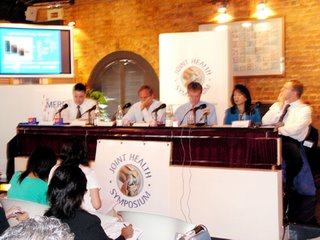JOINT HEALTH SYMPOSIUM - Hong Kong
New Study Points to 57 Million Sufferers by 2020
Many of Asia’s leading economies* are facing a joint health ‘time bomb’ according to new research presented today to an international gathering of experts.
The research uncovers for the first time the full extent of a potential joint health crisis facing five key countries in the region. It reveals that more than one in four adults (26%) aged between 29 and 64 suffered joint health problems in the last 12 months. In addition, of these sufferers, almost one in two (47%) say their condition has impacted significantly on their daily lives.
Guests at the Symposium, which featured a key-note address by Amye Leong, official spokesperson for the United Nations endorsed Bone and Joint Decade 2000-2010, were also warned that due to an ageing population in Asia, the joint health problem is set to deteriorate.
The research, conducted by leading international research institute Synovate and commissioned by Merck Consumer Health Care, was presented at the 2005 Joint Health Symposium, which brought together leading academics, healthcare professionals and experts in joint health from Asia, Europe and the Americas.
According to calculations based on official figures, demographic changes will see the population aged between 50 and 64 increase by a staggering 62% by 2010 in the five Asian markets surveyed*. In human terms, this will see more than 57 million sufferers beset by joint problems including damaged cartilage and painful inflammation commonly associated with arthritis.
The research conducted in five Asian markets – Indonesia, Malaysia, Hong Kong, Singapore and Taiwan – also highlights striking differences between neighboring countries. In Indonesia, for example, 44% of people questioned had suffered from joint health problems in the last 12 months compared to just 16% in Taiwan.
Furthermore, in the key 50-64 age group, where joint problems often require major surgical intervention, including knee and hip replacements, the differences become even more marked. In Indonesia for example, 65% of people from this age group reported joint pains compared to just 39% in Hong Kong.
The 2005 Merck CHC Joint Health Symposium
The 2005 Joint Health Symposium was convened by Merck Consumer Health Care (CHC), a wholly-owned subsidiary of the global Merck pharma-chemical business, to mark the launch of its Seven Seas Joint Health brand across Asia.
In addition to UN Bone and Joint Decade spokesperson Amye Leong, the audience of international experts and media also heard details of recent scientific research from Professors Bruce Caterson and John Harwood of Cardiff University in the United Kingdom, which for the first time provides clinical evidence of the role Cod Liver Oil can play in the maintenance of healthy joints. The active ingredient in the Seven Seas joint health brand is Cod Liver Oil, a primary source of Omega 3 / Tri-Omega.
The Cardiff University studies used Omega 3 / Tri-Omega fatty acids in culture systems to study their effects on cartilage metabolism. These studies were among the first in the world to demonstrate not only how but also why Cod Liver Oil (CLO) is effective in helping slow down the progression of cartilage destruction and reduced inflammatory mediators commonly associated with arthritis.
Professor Caterson and Team from Merck Indonesia
Professor Caterson and Professor Harwood’s latest scientific results, demonstrating the efficacy of Omega 3 (Cod Liver Oil) is planned to be published in early 2006.
Amye Leong, spokesperson for the United Nations-endorsed Bone and Joint Decade, addressed the audience about her devastating personal battle with arthritis as well as outlining the key objectives for one of the UN’s most important global health initiatives.
“Joint disease is an increasing problem in Asia and across the world. It is also a problem which is severely underestimated; 355 million people across the globe suffer from arthritis and it is predicted that by 2025, degenerative bone and joint disorders will be the commonest cause of physical disability. Much more needs to be done by governments, industry and the medical community to help raise awareness of how to prevent joint conditions” she said.
The launch of Seven Seas Joint Care
Leading executives from Merck CHC and Seven Seas spoke at the Joint Health Symposium about their commitment to make evidence-based natural treatments available to consumers across Asia.
In 2005, Merck CHC will launch its Seven Seas Joint Health brand in Hong Kong, Malaysia, Singapore, Indonesia and Taiwan. The brand will also go on sale in Thailand in 2006.
In Indonesia the Seven Seas Joint Health brand will be launched on September 30th, 2005 and will be known as Seven Seas JointCare.
Professor Handono Kalim, MD, PhD - President of Indonesian Rheumatology Association, discussing Arthritis in Indonesia to Indonesian Jounalists during country break-out session
According to Merck CHC, the latest Synovate research demonstrates a strong desire among consumers to maintain a healthy lifestyle. The data shows that 82% of adults already exercise regularly while 78% claim to eat a healthy diet. Significantly more than half of respondents (63%) also take over-the-counter treatments for their joint pains.
“This important new research into joint health in Asia, which also includes fascinating insights into the lives and attitudes of sufferers, suggests that there is a strong and largely unmet demand for evidence-based natural treatments that are available over the counter (OTC),” said Chris Zanetti, Managing Director of Seven Seas.
“This not only gives me confidence that the Seven Seas Joint Health brand can become a market leader in this region, but – as our commitment to science demonstrates – can also help to prevent a joint health time bomb exploding by making a significant contribution in alleviating the pain of sufferers.”



